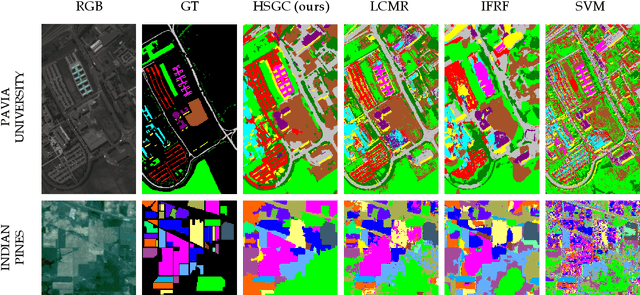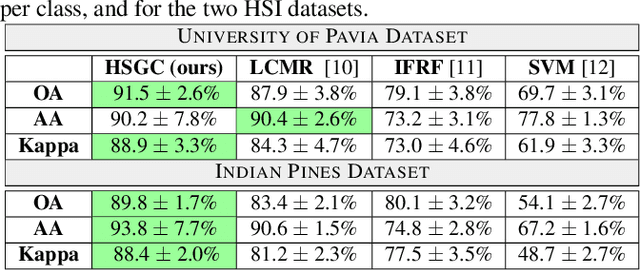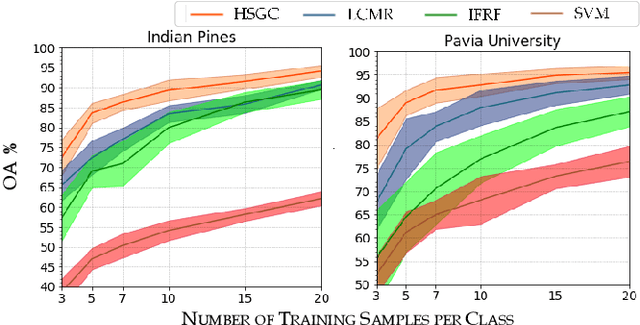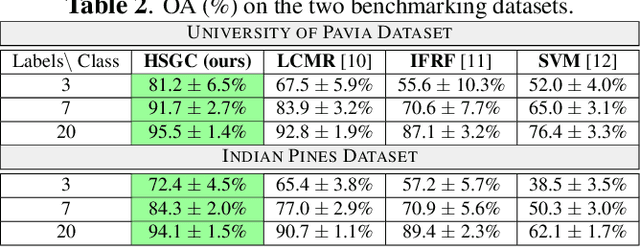Philip Sellars
LaplaceNet: A Hybrid Energy-Neural Model for Deep Semi-Supervised Classification
Jun 12, 2021



Abstract:Semi-supervised learning has received a lot of recent attention as it alleviates the need for large amounts of labelled data which can often be expensive, requires expert knowledge and be time consuming to collect. Recent developments in deep semi-supervised classification have reached unprecedented performance and the gap between supervised and semi-supervised learning is ever-decreasing. This improvement in performance has been based on the inclusion of numerous technical tricks, strong augmentation techniques and costly optimisation schemes with multi-term loss functions. We propose a new framework, LaplaceNet, for deep semi-supervised classification that has a greatly reduced model complexity. We utilise a hybrid energy-neural network where graph based pseudo-labels, generated by minimising the graphical Laplacian, are used to iteratively improve a neural-network backbone. Our model outperforms state-of-the-art methods for deep semi-supervised classification, over several benchmark datasets. Furthermore, we consider the application of strong-augmentations to neural networks theoretically and justify the use of a multi-sampling approach for semi-supervised learning. We demonstrate, through rigorous experimentation, that a multi-sampling augmentation approach improves generalisation and reduces the sensitivity of the network to augmentation.
GraphXCOVID: Explainable Deep Graph Diffusion Pseudo-Labelling for Identifying COVID-19 on Chest X-rays
Sep 30, 2020



Abstract:Can one learn to diagnose COVID-19 under extreme minimal supervision? Since the outbreak of the novel COVID-19 there has been a rush for developing Artificial Intelligence techniques for expert-level disease identification on Chest X-ray data. In particular, the use of deep supervised learning has become the go-to paradigm. However, the performance of such models is heavily dependent on the availability of a large and representative labelled dataset. The creation of which is a heavily expensive and time consuming task, and especially imposes a great challenge for a novel disease. Semi-supervised learning has shown the ability to match the incredible performance of supervised models whilst requiring a small fraction of the labelled examples. This makes the semi-supervised paradigm an attractive option for identifying COVID-19. In this work, we introduce a graph based deep semi-supervised framework for classifying COVID-19 from chest X-rays. Our framework introduces an optimisation model for graph diffusion that reinforces the natural relation among the tiny labelled set and the vast unlabelled data. We then connect the diffusion prediction output as pseudo-labels that are used in an iterative scheme in a deep net. We demonstrate, through our experiments, that our model is able to outperform the current leading supervised model with a tiny fraction of the labelled examples. Finally, we provide attention maps to accommodate the radiologist's mental model, better fitting their perceptual and cognitive abilities. These visualisation aims to assist the radiologist in judging whether the diagnostic is correct or not, and in consequence to accelerate the decision.
The GraphNet Zoo: A Plug-and-Play Framework for Deep Semi-Supervised Classification
Mar 13, 2020



Abstract:We consider the problem of classifying a medical image dataset when we have a limited amounts of labels. This is very common yet challenging setting as labelled data is expensive, time consuming to collect and may require expert knowledge. The current classification go-to of deep supervised learning is unable to cope with such a problem setup. However, using semi-supervised learning, one can produce accurate classifications using a significantly reduced amount of labelled data. Therefore, semi-supervised learning is perfectly suited for medical image classification. However, there has almost been no uptake of semi-supervised methods in the medical domain. In this work, we propose a plug-and-play framework for deep semi-supervised classification focusing on graph based approaches, which up to our knowledge it is the first time that an approach with minimal labels has been shown to such an unprecedented scale. We introduce the concept of hybrid models by defining a classifier as a combination between a model-based functional and a deep net. We demonstrate, through extensive numerical comparisons, that our approach readily compete with fully-supervised state-of-the-art techniques for the applications of Malaria Cells, Mammograms and Chest X-ray classification whilst using far fewer labels.
Two Cycle Learning: Clustering Based Regularisation for Deep Semi-Supervised Classification
Jan 15, 2020



Abstract:This works addresses the challenge of classification with minimal annotations. Obtaining annotated data is time consuming, expensive and can require expert knowledge. As a result, there is an acceleration towards semi-supervised learning (SSL) approaches which utilise large amounts of unlabelled data to improve classification performance. The vast majority of SSL approaches have focused on implementing the \textit{low-density separation assumption}, in which the idea is that decision boundaries should lie in low density regions. However, they have implemented this assumption by treating the dataset as a set of individual attributes rather than as a global structure, which limits the overall performance of the classifier. Therefore, in this work, we go beyond this implementation and propose a novel SSL framework called two-cycle learning. For the first cycle, we use clustering based regularisation that allows for improved decision boundaries as well as features that generalises well. The second cycle is set as a graph based SSL that take advantages of the richer discriminative features of the first cycle to significantly boost the accuracy of generated pseudo-labels. We evaluate our two-cycle learning method extensively across multiple datasets, outperforming current approaches.
GraphX$^{NET}-$ Chest X-Ray Classification Under Extreme Minimal Supervision
Jul 25, 2019



Abstract:The task of classifying X-ray data is a problem of both theoretical and clinical interest. Whilst supervised deep learning methods rely upon huge amounts of labelled data, the critical problem of achieving a good classification accuracy when an extremely small amount of labelled data is available has yet to be tackled. In this work, we introduce a novel semi-supervised framework for X-ray classification which is based on a graph-based optimisation model. To the best of our knowledge, this is the first method that exploits graph-based semi-supervised learning for X-ray data classification. Furthermore, we introduce a new multi-class classification functional with carefully selected class priors which allows for a smooth solution that strengthens the synergy between the limited number of labels and the huge amount of unlabelled data. We demonstrate, through a set of numerical and visual experiments, that our method produces highly competitive results on the ChestX-ray14 data set whilst drastically reducing the need for annotated data.
Superpixel Contracted Graph-Based Learning for Hyperspectral Image Classification
Mar 19, 2019



Abstract:A central problem in hyperspectral image classification is obtaining high classification accuracy when using a limited amount of labelled data. In this paper we present a novel graph-based framework, which aims to tackle this problem in the presence of large scale data input. Our approach utilises a novel superpixel method, specifically designed for hyperspectral data, to define meaningful local regions in an image, which with high probability share the same classification label. We then extract spectral and spatial features from these regions and use these to produce a contracted weighted graph-representation, where each node represents a region rather than a pixel. Our graph is then fed into a graph-based semi-supervised classifier which gives the final classification. We show that using superpixels in a graph representation is an effective tool for speeding up graphical classifiers applied to hyperspectral images. We demonstrate through exhaustive quantitative and qualitative results that our proposed method produces accurate classifications when an incredibly small amount of labelled data is used. We show that our approach mitigates the major drawbacks of existing approaches, resulting in our approach outperforming several comparative state-of-the-art techniques.
Semi-supervised Learning with Graphs: Covariance Based Superpixels For Hyperspectral Image Classification
Jan 15, 2019



Abstract:In this paper, we present a graph-based semi-supervised framework for hyperspectral image classification. We first introduce a novel superpixel algorithm based on the spectral covariance matrix representation of pixels to provide a better representation of our data. We then construct a superpixel graph, based on carefully considered feature vectors, before performing classification. We demonstrate, through a set of experimental results using two benchmarking datasets, that our approach outperforms three state-of-the-art classification frameworks, especially when an extremely small amount of labelled data is used.
 Add to Chrome
Add to Chrome Add to Firefox
Add to Firefox Add to Edge
Add to Edge